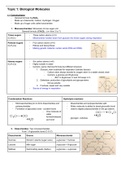Summary
Summary Complete notes on AS/A level Biology B with the Pearson Edexcel exam board- Topics 1 to 3
- Course
- Institution
- Book
This includes the perfect and complete summary notes from Topics 1 to 3 for the Biology B AS/A level exam using the Pearson Edexcel exam board. These notes are written following the Pearson Edexcel Specification, including all the necessary requirements according to the specification. They also in...
[Show more]





